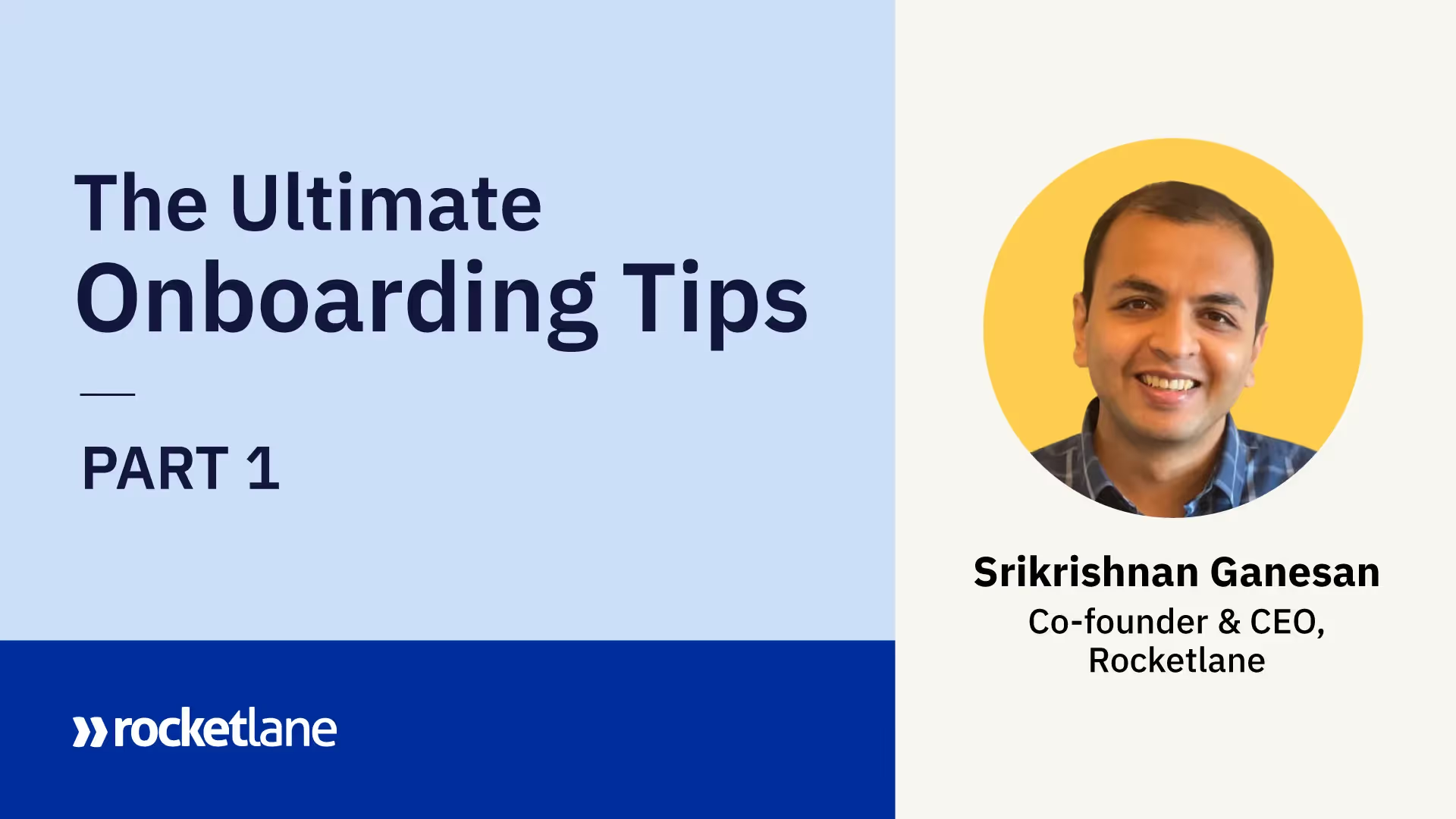Part I: Let’s talk about the basics
If you’ve been reading our blog, you probably know how much we care about customer onboarding and how hard we try to make a difference in this space. Over the years, our team has onboarded several customers across multiple industries, burnt their fingers, and learned many valuable lessons along the way.
This crucial post-sale period can truly help you define and establish a harmonious working relationship with your customer (quality of your product notwithstanding).
To help you navigate your onboarding journey and ensure you don’t make the same mistakes we did, we’ve compiled a list of 15 valuable onboarding tips in a 3-part blog.
We hope to inspire and challenge you to take your onboarding game to the next level and deliver a consistently world-class experience to every single one of your customers. Let’s jump right in.
Tip #1: Get customers to co-own your success criteria
When your product/offering is successfully implemented and delivers value, your customer wins in more ways than one. The business gets its ROI from your offering, the executive who made the purchase looks good, the functional leads involved in the implementation are up for more responsibilities and/or promotions.
If this is the case, then why should getting to that value be your responsibility alone?
Yes, your product needs to do its thing. And it is true that you are the expert and should guide the customer to get the most out of your offering.
But it is equally the customer's job to get work done on time at their end, to help you with their organizational priorities. They have to help you navigate their systems and people to successfully deploy the solution they bought. They know their people best and how to make the adoption happen.
So it makes sense to sign up the team leads or managers at the customer’s end for specific goals. Here are examples of the kind of goals that should make it to the KRAs they're measured on.
1. Did we launch on time?
Customers should be working with you on time-to-launch, rather than against you by increasing scope. So make sure you get them aligned.
2. Team Usage/Adoption
Team leads on the customer side know their team the best. They should co-own and drive the process with your insights and ideas. Change management and adoption need the right kind of evangelism and training, and your customers should be working shoulder to shoulder with you on these initiatives.
3. Hitting ROI goals
Customers should also work towards making your product successful. It takes more than technology for a new solution to create value. It takes intent and thoughtfulness on the customer side to figure out how to make the most of the software they purchased.
As your customers set their OKRs for the quarter, make sure their managers are held accountable for the success of your product!

Tip #2: Use project plans, not checklists
In the early days of any SaaS business, we underestimate what it takes to go live with our customers. We all believe our product is easy to configure, adopt, and use. If someone asks you how long it would take to get set up with your product, you'd say hours or days - not weeks or months.
But as we start working with our first few customers, we understand how complex the implementations are. Configurations need the customer to give it some thought; integrations need the involvement of other team members on your side or the customer’s side; data migrations can be very tricky, and training and adoption for larger teams are non-trivial.
So we start putting together spreadsheets or Trello boards with a checklist of tasks that need to happen before you can go live.
Now your answer becomes a more reasonable "2-3 weeks" for the question, "How long does it take to go live with your solution?" But the problem is, it sometimes takes over six weeks. And most customers end up feeling like they are nearly done with every item on your checklist but still not getting over the finish line.
What's the actual problem here?
When you hand the customer an 18-point checklist, they scurry away to get all of them done. They make good progress but only get to 50-60% on many items without a path to completion from there. This is usually because of a lack of focus.
So it helps to divide the journey into a plan of what to get done each week. Make it a path or a sequence of steps that establish the best order in which you'd want them to approach these steps.
This can take into account:
a. The dependencies
b. The least path of resistance to make some good progress early on
c. Themes into which you can divide weeks to ensure that related work is completed together, and involvement of other teams is spread over a particular timeframe.
So it makes sense to think of this as a project plan with specific themes each week, and deadlines around particular tasks in a sequence. The plan has due dates on tasks, assignees, dependencies, subtasks, etc., to facilitate easy consumption of planned work in a period of time. It is more effective to approach the work in this manner than as a checklist.
If you haven't had the time to come up with your own project implementation plans, here's a sample template you can to get started!

Tip #3: Adapt onboarding plans based on customer maturity
Don't take a one-size-fits-all approach to your onboarding methodology. It helps to have an acute awareness of customer maturity to build out the right onboarding plan for your customers.
It makes sense to have variations of your onboarding methodology based on the customer's state of affairs and abilities.
For instance, at Rocketlane, we sell to companies of varied sizes and stages.
So while some of them may be interested in starting afresh from a sample template even to begin moving from reactive chaos to having a plan for the customer, others may want to learn how to iterate on their existing methodology. Some may want to understand how to move from a competitor's product to yours.
Likewise, an onboarding plan that looks simple to an SMB customer may feel too shallow or make you look under-prepared to an enterprise customer. A comprehensive plan that an enterprise may love can drive an SMB customer away if they think it's "overwhelming."
So Tip #3 is for you to actively think about patterns and customer segments - like customer size, process, and people maturity, and craft the right experience for each of them. If you need help doing this, reach out and we'll guide you - we've helped many teams in the past.

Tip #4: Do more workshops, and less "homework"
Here's one of the most critical lessons we have learned the hard way. When a customer is implementing your tool, you need a Program Manager or an Operations team involved in the process to set up your product.
Most other team members are busy with their daily work, tackling irate customers, hiring for the teams, or jumping from meeting to meeting. So if you give them more work to do between your customer onboarding calls, they put it off for later since their daily activities are prioritized. And that takes up most of their time. So they end up not doing their homework before your next onboarding meeting, and things get delayed.
The solution?
Block time on their calendars to do this together. Doing things as a "workshop" makes it a forcing function to get work done. The inertia from the customer side is lower this way, and you are there to guide them in their activities. You could also record the session and give them the video for future reference. It takes more of your team's time, but it becomes a win-win situation.
Gainsight says that a workshop approach to their product configurations helped reduce their customer onboarding time by 66%!
Guess what? You can also learn more from watching your customers use your product as a side benefit.

Tip #5: Branding your customer onboarding methodology
If you're a CS or PS leader, make this your goal for 2023: "Our customer onboarding should be PR-worthy!"
Here's why.
Phenom TXM and Darwinbox recently gave their implementation methodology a name and had a PR announcement to introduce a new way to onboard their customers.
The objective of this exercise was to demonstrate their ability to execute complex implementations and to get their customers to launch and value realization on time. This would, in turn, help them sell more.
The onboarding teams in these companies are no longer cost centers or services teams but are part of the competitive advantage. Think about that!
SaaS has not lived up to the promise of simplicity and things just working out of the box.
For enterprise companies buying SaaS, there are still hit-or-miss experiences in their onboarding and implementation journey:
- Flaky integrations
- Poor collaboration
- Lack of visibility into the process
- Delays on both sides
- Inconsistent execution
This is why it's important to have a well-thought-out onboarding methodology and to bring some seriousness around the projects.
How can you achieve this?
- Draw the patterns from your customer onboarding checklists and project plans to develop weekly or bi-weekly themes for your major activities (Check this template out for ideas).
- Use these themes to develop names for key phases in your project execution.
- Formalize your methodology using a flow diagram with these phases and have an overall name for your methodology itself.
- Communicate your formal methodology before and after your sale closes to ensure the customer takes the process seriously and puts the right resources on this project from their end.


























.webp)